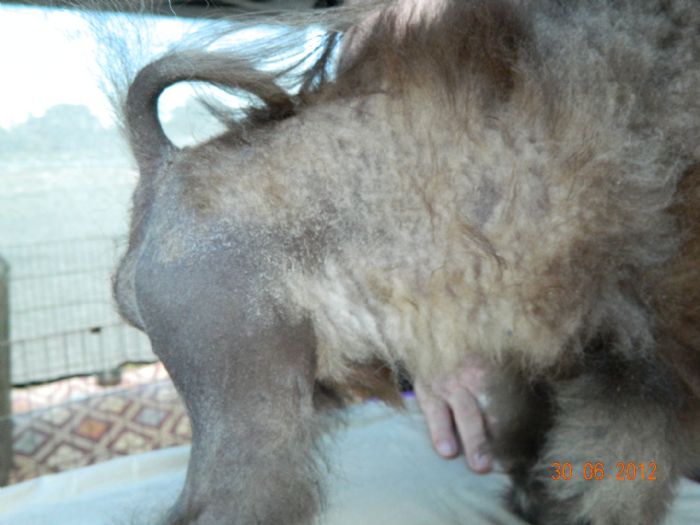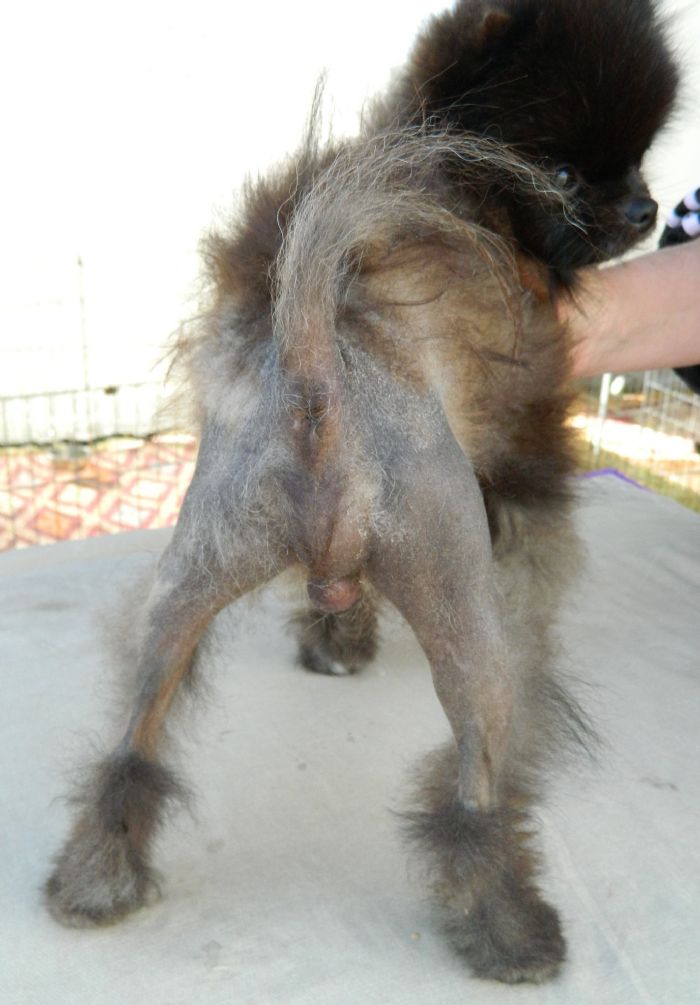What is Alopecia X?
Alopecia X is an inherited condition that affects Pomeranians resulting in mild to severe hair loss. Alopecia X is also regularly referred to as Black Skin Disease (BSD) as the affected areas where skin becomes exposed to sunlight typically can become quite darkened. Alopecia is the general term for coat loss however the use of the "X" signifies that it is coat loss of unknown origin as Alopecia X is a diagnosis by exclusion, ie all other typical known causes of coat loss have been tested and excluded such as thyroid dysfunction, adrenal dysfunction, skin parasites etc. The age of being affected varies however these can generally be grouped in to "early onset" and "late onset". The former is generally associated with puppies who have large volumes of cottonish looking coats, quite often greyish colour (except head and legs), which do not cycle the puppy coat through 4-8 months and they become affected with severe coat loss instead of growing new adult coat. In cases of late onset coat loss the puppies generally appear to go through normal coat cycles and have an apparent correct double coat until 2-4 years old or later and then suffer from coat cycle arrest and the coat loss when it occurs tends to be more gradual than early onset cases. Males are seen to be affected more often than females and all coat colours are affected.
The coat loss of affected Pomeranians can range in severity however it is generally symmetrical in nature on both sides of the body and tends to start from around the base of the tail or thigh area. Progression of coat loss varies with severe cases typically having complete hair loss on the body except for the head and lower limbs. Prior to coat loss occurring the tail hair generally thins (ie not the typical large plumage of a Pomeranian) and the body coat tends to lack colour, become dull, dry, lifeless and can clump together. Other nordic/spitz breeds also have similar cases of severe coat loss however the prevalence in those breeds is less. Some affected Pomeranians may recoat spontaneously and others never recoat again. Various veterinary medications are available to assist in attempted recoating with inconsistent success and generally the coat is still abnormal even when recoated and the recoating not necessarily permanent. Affected animals should be removed from breeding programs and when neutered it can possibly lead to recoating. Poms that do recoat (with or without intervention) can again lose coat in future.
What has happened to Pomeranian coat?
Significant research has been undertaken on Alopecia X by a number of scientists however that being undertaken by the Institute of Genetics at the University of Bern in Switzerland is the most prominent. The use of recent technology advances has made the progress encouraging for this particular research activity which has funding support from the Canine Health Foundation as well as many breed clubs and breeders worldwide.
Until such time that a DNA marker is available (if ever), some things that can be done to minimize risk in Pomeranian breeding programs and also to in general help reduce the proliferation of Alopecia X through the breed are the following:
- Engage with knowledgeable breeders worldwide experienced with Alopecia X to gain information.
- When purchasing new Poms seek to validate there has been no Alopecia X producers and/or the progeny of Alopecia X affecteds (ie both being assumed carriers) for at least 2 generations.
- Only have limited use of new stud dogs until 4 years old where then at an age of likely showing signs of being affected.
- When using outside line stud dogs seek to validate their prior coat history and ideally observe coats of progeny sired by them.
- Monitor the coat cycling and coat types of all Poms owned (including use of selective clipping to see if regular coat growth is occurring) and either exclude or delay using those considered abnormal, look for vibrant healthy coats and no periods of coat cycle arrest. Similarly also observe progeny of Poms bred of any placed in to other homes through to at least 4 years old.
- Remove any affected Poms or their progeny from your breeding program, it does not really matter if the coat issue is caused by this or that and may NEVER be known, but a coat issue IS a coat issue and should be excluded from breeding programs, this issue requires vigilence!
- Promote awareness of Alopecia X in the Pomeranian Community.
- Encouraging openness, honesty and vigilance regarding Alopecia X.
- Support Alopecia X research through provision of blood samples and donations.
This is also a great short article about ways to reduce risk of Alopecia X in your breeding program, "The Cult of Youth or Breeding Away from the Coat Problem".
The coat quality in our Poms is something that we are very proud of, RICH VIBRANT COLOUR with slow maturing correct textured double coat and no periods of coat cycle arrest. With generation after generation of responsible breeding we are hopefully reducing our risk profile in our breeding program for this problem, whilst worldwide an accelerated rate of proliferation occurs through combinations of lack of awareness, ignorance, apathy, selfishness and dishonesty. One thing is for sure with this breed problem is that breeders repeating history will NOT change the future!



